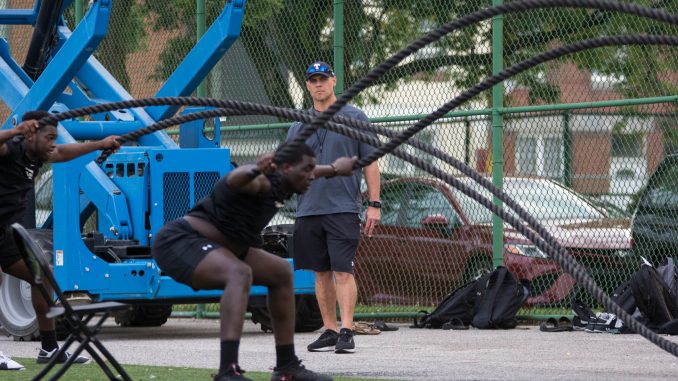
Temple University football players went from lifting three times a week to just twice a week, said Temple football head strength and conditioning coach Brad Ohrt.
But, Ohrt doesn’t feel the team is behind, as they had an extra month of training before their first game on Oct. 10.
“There’s been schools and places I’ve been in the past where all we had to work with was two lifts a week, but in our situation, you can make it work in a seven week window,” Ohrt said. “Normally you’re talking about 12 to 14 weeks a season and two lifts per week, that’s not gonna cut it.”
The team will have a shortened season this fall and accordingly less time for training. Even during the pandemic, Temple’s strength and conditioning program is focused on preparing players for the professional level and helping them perform at their peak during the season.
With the strength and conditioning program Ohrt has designed for each player, he thinks they should be able to clean, press and squat on Tuesdays and Thursdays until the end of season.
“If we can get a stronger squat, a stronger more forceful push in the ground to create power on the clean,” Ohrt added. “All of those things are going to carry in each position onto the field.”
Ohrt is a firm believer in creating a single work program for all positions, he said.
At the beginning of the season, Ohrt determines a five-pound weight range for the players to stay within while playing based on how they perform in the beginning of preseason, he said.
Ohrt’s program is meant to prepare players for the NFL, he said, but his strength and conditioning program differs from the program the Philadelphia Eagles uses for their players.
The Eagles lift heavy during the offseason, but in-season training is focused on preparing players for their specific positions, said Mike Minnis, Eagles coordinator of performance nutrition and assistant strength and conditioning coach.
Minnis and the Eagles set body weight goals six times a year, taking into consideration the players’ frame, how tall they are, their wingspan, their body composition and body fat, he added.
“If I have a running back who’s 200 lbs, and I think they should be 205 lbs based on their frame, but their body fat is 20 percent it’s too high and getting them to 205 lbs won’t help,” Minnis said. “So maybe they’ll have to drop to 190 to 195 to get them into better body fat range for speed and the ability to change direction.”
Ohrt and Minnis are both involved in planning their teams’ diet plans and meals which is an important factor in how a player performs on the field, Ohrt said.
When Minnis plans the Eagles players’ diets, he wants players to have options to build a healthy plate or splurge and intake high calories, he said.
“It’s up to us to educate the guys what they eat will determine the kind of body they want to have,” Minnis added.
Lori Lorditch, Temple’s dietitian, has worked with Ohrt and the team to educate them on a “sustainable diet,” Lorditch said.
“Getting good amounts of dietary fat from nuts, seeds, olive oil and avocados, these healthy fats can decrease muscle sources and inflammation in the body,” she added.
Temple Athletics provides catering through Aramark and Ohrt works closely with the company on instilling healthier options for the team, he said.
“They usually come up with three to four protein options,” Ohrt said. “We do have some comfort foods on there because we do need some of the calories for these guys.”
Although it can be difficult to keep players motivated at times, they understand following Ohrt’s plan will benefit them in the long run, Ohrt said.
“The team knows we have the best interest in heart, some days they don’t want to do the workout,” Ohrt added. “But we can’t afford to miss those workouts because this is how they become a better player and protect themselves from injury.”


Be the first to comment